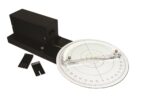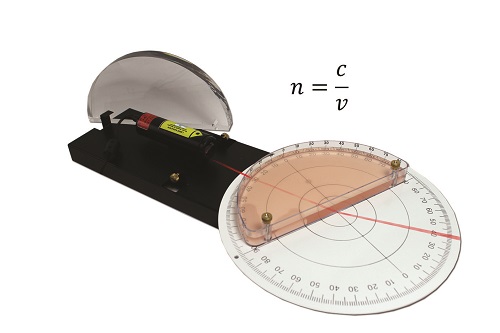Reflection – Refraction : EXP200030
This experiment will let you view light at the surface of a diopter.
This experiment will let you view light at the surface of a diopter. You will highlight light reflection and refraction phenomena according to the medium that light passes through. Application of Snell-Descartes’ law, approached during the theoretical class, takes on here an obvious playful and experimental aspect. You can also use the semi-cylindrical tank to find the refractive index of a medium and determine from it the speed of propagation of light in this medium. This experimental kit comprises a lantern, a laser diode with line generator, and a graduated mechanical assembly consisting of slits, a Plexiglas disk and a semi-cylindrical tank.
HIGHLIGHTING REFRACTION
Refraction is the change in direction of a ray of light when it passes over the surface of two different transparent media. Snell Descartes’ law can be checked by reading the incident ray angle and the refracted ray angle with the graduated disk.
The angles of three refracted rays can also be compared by placing a multi-slit at the outlet of the lantern.
CALCULATING THE MEDIUM INDEX
A liquid with an unknown refractive index is placed in the semicylindrical tank (sweetened water, oil, etc). Then, an incident ray is made to enter this tank by means of a laser equipped with a line generator. The angle of the refracted ray with respect to normal is identified, thus allowing us to find the refractive index of the medium. We can then use this index to calculate the speed of light in this medium with the
equation n=c/v.
HIGHLIGHTING TOTAL REFLECTION
The phenomenon of total reflection occurs when a ray of light reaches the surface of separation of two media with different optical indices with an angle of incidence greater than a critical value. The ray is no longer refracted but reflected. This is the principle of diffusion that we find in optical fibres. The half cylinder is placed directly at the outlet of the lantern (a beam is generated with a slit) or the laser. The ray of light will pass from a more refractive medium (Plexiglas) to a less refractive medium (air). By rotating the graduated disk, the angle of total reflection is found.
SUBJECTS APPROACHED
»»Snell-Descartes’ law
»»Reflection study
»»Refraction study
»»Total or partial reflection
»»Limit angle of refraction
»»Medium index
»»Reflection spectral analysis
»»Notion of refractivity
NECESSARY EQUIPMENT
| Reference | Description | quantity |
| POD063202 | Mechanical parts for Discoptic | 1 |
| POD063203 | Laser for Discoptic | 1 |
| POD060200 | Lantern for Discoptic, with power supply | 1 |
- Non catégorisé
- Electrical Engineering
- PHYSICS
- Energy & Systems
- Catalogues
- PDF catalogues




